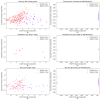AI-Assisted Detection for Early Screening of Acute Myeloid Leukemia Using Infrared Spectra and Clinical Biochemical Reports of Blood
- PMID: 40281699
- PMCID: PMC12024367
- DOI: 10.3390/bioengineering12040340
AI-Assisted Detection for Early Screening of Acute Myeloid Leukemia Using Infrared Spectra and Clinical Biochemical Reports of Blood
Abstract
Early detection and accurate diagnosis of leukemia pose significant challenges due to the disease's complexity and the need for minimally invasive methods. Acute myeloid leukemia (AML) accounts for most cases of adult leukemia, and our goal is to screen out some AML from adults. In this work, we introduce an AI-enhanced system designed to facilitate early screening and diagnosis of AML among adults. Our approach combines the infrared absorption spectra of serum measured with attenuated total reflectance Fourier transform infrared spectroscopy (ATR-FTIR), which identifies distinctive molecular signatures in lyophilized serum, together with standard clinical blood biochemical test results. We developed a multi-modality spectral transformer network (MSTNetwork) to generate latent space feature vectors from these datasets. Subsequently, these vectors were assessed using a linear discriminant analysis (LDA) algorithm to estimate the likelihood of acute myeloid leukemia. By analyzing blood samples from leukemia patients and the negative control (including non-leukemia patients and healthy individuals), we achieved rapid and accurate prediction and identification of acute myeloid leukemia among adults. Compared to conventional methods relying solely on either FTIR spectra or biochemical indicators of blood, our multi-modality classification system demonstrated higher accuracy and sensitivity, ultimately achieving an accuracy of 98% and a sensitivity of 98%, improving the sensitivity by 12% (compared with using only biochemical indicators) or over 6% (compared with using only FTIR spectra). Our multi-modality classification system is also very robust as it gave much smaller standard deviations of the accuracy and sensitivity. Beyond improving early detection, this work also contributes to a more sustainable and intelligent healthcare sector.
Keywords: acute myeloid leukemia; artificial intelligence; blood analysis; early screening; infrared spectroscopy.
Conflict of interest statement
Author Sailing He was also affiliated with Taizhou Agility Smart Technologies. The remaining authors declare that the research was conducted in the absence of any commercial or financial relationships that could be construed as a potential conflict of interest.
Figures








Similar articles
-
Identification of acute myeloid leukemia by infrared difference spectrum of peripheral blood.J Pharm Biomed Anal. 2023 Sep 5;233:115454. doi: 10.1016/j.jpba.2023.115454. Epub 2023 May 10. J Pharm Biomed Anal. 2023. PMID: 37178631
-
Attenuated Total Reflectance-Fourier Transform Infrared (ATR-FTIR) Spectroscopy Discriminates the Elderly with a Low and High Percentage of Pathogenic CD4+ T Cells.Cells. 2022 Jan 28;11(3):458. doi: 10.3390/cells11030458. Cells. 2022. PMID: 35159268 Free PMC article.
-
Segregation of ovarian cancer stage exploiting spectral biomarkers derived from blood plasma or serum analysis: ATR-FTIR spectroscopy coupled with variable selection methods.Biotechnol Prog. 2015 May-Jun;31(3):832-9. doi: 10.1002/btpr.2084. Epub 2015 Apr 29. Biotechnol Prog. 2015. PMID: 25832726
-
Fourier-transform infrared spectroscopy coupled with a classification machine for the analysis of blood plasma or serum: a novel diagnostic approach for ovarian cancer.Analyst. 2013 Jul 21;138(14):3917-26. doi: 10.1039/c3an36654e. Epub 2013 Jan 17. Analyst. 2013. PMID: 23325355
-
Acute Leukemia Diagnosis Through AI-Enhanced Attenuated Total Reflection Fourier Transform Infrared Spectroscopy of Peripheral Blood Smears.Appl Spectrosc. 2025 Jun;79(6):967-985. doi: 10.1177/00037028241303526. Epub 2024 Dec 26. Appl Spectrosc. 2025. PMID: 39726177
Cited by
-
A Unified YOLOv8 Approach for Point-of-Care Diagnostics of Salivary α-Amylase.Biosensors (Basel). 2025 Jul 2;15(7):421. doi: 10.3390/bios15070421. Biosensors (Basel). 2025. PMID: 40710071 Free PMC article.
References
-
- Eigendorff E., Hochhaus A. Acute leukemia in adults. Pathologe. 2015;36:503–517. - PubMed
-
- Hjalgrim L.L., Rostgaard K., Schmiegelow K., Soderhall S., Kolmannskog S., Vettenranta K., Kristinsson J., Clausen N., Melbye M., Hjalgrim H., et al. Age- and sex-specific incidence of childhood leukemia by immunophenotype in the Nordic countries. J. Natl. Cancer Inst. 2003;95:1539–1544. - PubMed
Grants and funding
- No. 2025KY437/the Medical and Health Research Project of Zhejiang Province
- 2023C03083/Pioneer' and 'Leading Goose' R&D Program of Zhejiang Province
- 2024C03045/'Pioneer' and 'Leading Goose' R&D Program of Zhejiang Province
- 2022YFC3601000/the National Key Research and Development Program of China
- W2412107/National Natural Science Foundation of China
LinkOut - more resources
Full Text Sources
Miscellaneous

